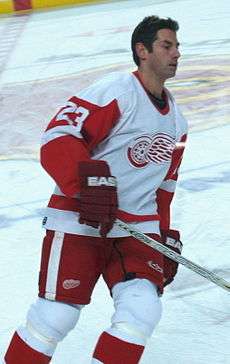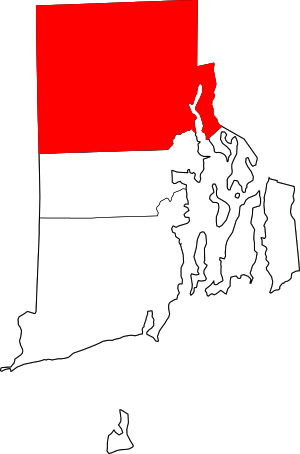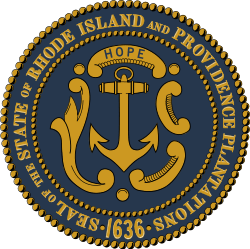Woonsocket, Rhode Island
Woonsocket (/wʊnˈsɒkɪt, wən-/ (![]()
City of Woonsocket | |
|---|---|
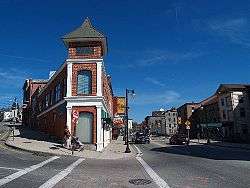 Downtown Woonsocket | |
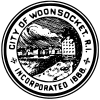 Seal | |
| Motto(s): "A City on the Move" | |
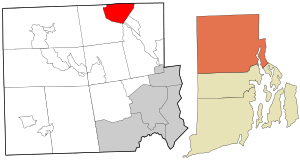 Location in Providence County and the state of Rhode Island | |
| Coordinates: 42°00′30″N 71°30′58″W | |
| Country | |
| State | |
| County | Providence |
| Incorporated (town) | 1867 |
| Incorporated (city) | 1888 |
| Government | |
| • Type | Mayor-council |
| • Mayor | Lisa Baldelli-Hunt |
| Area | |
| • Total | 7.94 sq mi (20.56 km2) |
| • Land | 7.75 sq mi (20.06 km2) |
| • Water | 0.19 sq mi (0.50 km2) |
| Elevation | 184 ft (56 m) |
| Population (2010) | |
| • Total | 41,186 |
| • Estimate (2019)[2] | 41,751 |
| • Density | 5,390.01/sq mi (2,081.06/km2) |
| Time zone | UTC−5 (Eastern) |
| • Summer (DST) | UTC−4 (Eastern) |
| ZIP Code | 02895 |
| Area code(s) | 401 |
| FIPS code | 44-80780[3] |
| GNIS feature ID | 1219339[4] |
| Website | www.woonsocketri.org |
The city is the corporate headquarters of CVS Health, a pharmacy services provider. It is home to Landmark Medical Center, the Museum of Work and Culture and the American-French Genealogical Society.[5]
History
Before the arrival of European settlers in northern Rhode Island during the 17th century, today's Woonsocket region was inhabited by three Native American tribes—the Nipmucs (Cowesett), Wampanoags, and Narragansetts.[6] In 1661, the English theologian Roger Williams purchased the area from the "Coweset and Nipmucks", and in a letter referred to modern day Woonsocket as "Niswosakit".[7]
Other possible derivations to the name include several Nipmuc geographic names from nearby Massachusetts. These include Woonksechocksett, from Worcester County meaning "fox country", and Wannashowatuckqut, also from Worcester County, meaning "at the fork of the river".[8] Another theory proposes that the city was named after Woonsocket Hill in neighboring North Smithfield.[9]
Woonsocket Falls Village was founded in the 1820s. Its fortunes expanded as the Industrial Revolution took root in nearby Pawtucket. With the Blackstone River providing ample water power, the region became a prime location for textile mills. In 1831 Edward Harris built his first textile mill in Woonsocket. Woonsocket as a town was not established until 1867 when three villages in the town of Cumberland, namely Woonsocket Falls, Social and Jenckesville, officially became the town of Woonsocket.
In 1871, three additional industrial villages[10] from Smithfield– Hamlet, Bernon, and Globe, were added to the town establishing its present boundaries. Woonsocket was incorporated as city in 1888.
With the growth of industries came a new influx of immigrants, predominantly Québecois and French-Canadians from other provinces. When the Société Saint-Jean-Baptiste d'Holyoke organized a national cultural and benefit society in 1899, the Union Saint-Jean-Baptiste d’Amérique, Woonsocket, with its proximity to several industrial areas having large French-Canadian demographics, was chosen for the organization's headquarters.[11] By 1913, a survey by the American Association of Foreign Language Newspapers found the city had to have the 6th largest population of French or French-Canadian foreign nationals in the country.[12] In the decades that followed this population grew, and by time the local textile industry shuttered during the Great Depression the demographic comprised 75 percent of the population. French-language newspapers were published and sold; radio programs, movies, even most public conversations were conducted in French.[13] As recently as 1980, 70% of Woonsocket's population was of French-Canadian descent, though the New England French they had once spoken had gradually declined and vanished from the public dialogue.[14]
Throughout the 20th century the city's fortunes ebbed and flowed with the national trends. During the Great Depression the textile economy of Woonsocket came to an effective standstill however it would revived during World War II, when the city became a major center of fabric manufacturing for the war effort. In the postwar years, the Woonsocket economy diversified as manufacturing declined and other commercial sectors like retail, technology and financial services took hold.[10] However, in the early 1980s Woonsocket was again plagued by high unemployment rates.[14]
Beginning in 1979, Woonsocket became home to Autumnfest, an annual cultural festival that takes place on Columbus Day Weekend, at World War II Veteran's Memorial State Park. It has become one of the city's most popular events.[15]
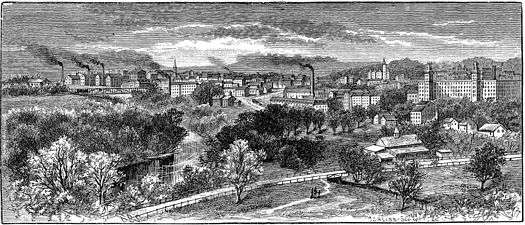 Woonsocket from the East, 1886 engraving
Woonsocket from the East, 1886 engraving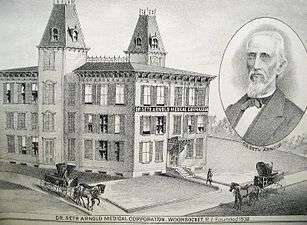 Woonsocket Medical Corporation, founded in 1839 by Dr. Seth Arnold
Woonsocket Medical Corporation, founded in 1839 by Dr. Seth Arnold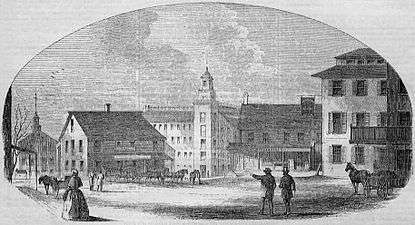 Woonsocket in 1855 (published in Gleason's Pictorial Drawing-Room Companion
Woonsocket in 1855 (published in Gleason's Pictorial Drawing-Room Companion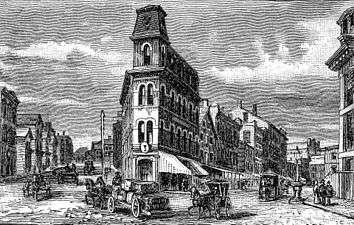 1886 engraving
1886 engraving
Geography
According to the United States Census Bureau, the city has a total area of 8.0 square miles (21 km2), of which 7.7 square miles (20 km2) is land and 0.3 square miles (0.78 km2) (3.14%) is water. Woonsocket is drained by the Blackstone River. Adjacent communities include Blackstone and Bellingham, Massachusetts, along with Cumberland and North Smithfield, Rhode Island.
Climate
Woonsocket has a strong humid continental climate (Köppen Dfa) with four distinct seasons. Being influenced by both the sea and the interior during winter, diurnal temperature variation is high, with days most often being above freezing before severe frosts hit at night.
| Climate data for Woonsocket, Rhode Island | |||||||||||||
|---|---|---|---|---|---|---|---|---|---|---|---|---|---|
| Month | Jan | Feb | Mar | Apr | May | Jun | Jul | Aug | Sep | Oct | Nov | Dec | Year |
| Record high °F (°C) | 68 (20) |
70 (21) |
87 (31) |
94 (34) |
97 (36) |
102 (39) |
102 (39) |
104 (40) |
96 (36) |
90 (32) |
82 (28) |
76 (24) |
104 (40) |
| Average high °F (°C) | 37 (3) |
40 (4) |
49 (9) |
59 (15) |
70 (21) |
79 (26) |
84 (29) |
82 (28) |
75 (24) |
64 (18) |
53 (12) |
42 (6) |
61 (16) |
| Average low °F (°C) | 13 (−11) |
16 (−9) |
25 (−4) |
35 (2) |
45 (7) |
55 (13) |
60 (16) |
59 (15) |
49 (9) |
37 (3) |
30 (−1) |
20 (−7) |
37 (3) |
| Record low °F (°C) | −25 (−32) |
−20 (−29) |
−13 (−25) |
11 (−12) |
25 (−4) |
31 (−1) |
38 (3) |
30 (−1) |
23 (−5) |
15 (−9) |
−2 (−19) |
−16 (−27) |
−25 (−32) |
| Average precipitation inches (mm) | 4.52 (115) |
3.40 (86) |
4.11 (104) |
4.22 (107) |
3.59 (91) |
3.83 (97) |
3.65 (93) |
4.20 (107) |
4.12 (105) |
4.26 (108) |
4.60 (117) |
4.05 (103) |
48.55 (1,233) |
| Average snowfall inches (cm) | 11.3 (29) |
12.5 (32) |
7.4 (19) |
1.5 (3.8) |
0.2 (0.51) |
0 (0) |
0 (0) |
0 (0) |
0 (0) |
0 (0) |
1.7 (4.3) |
8.2 (21) |
42.8 (109.61) |
| Source 1: [16] | |||||||||||||
| Source 2: [17] | |||||||||||||
Demographics
| Historical population | |||
|---|---|---|---|
| Census | Pop. | %± | |
| 1870 | 11,527 | — | |
| 1880 | 16,050 | 39.2% | |
| 1890 | 20,830 | 29.8% | |
| 1900 | 28,204 | 35.4% | |
| 1910 | 38,126 | 35.2% | |
| 1920 | 43,496 | 14.1% | |
| 1930 | 49,376 | 13.5% | |
| 1940 | 49,303 | −0.1% | |
| 1950 | 50,211 | 1.8% | |
| 1960 | 47,080 | −6.2% | |
| 1970 | 46,820 | −0.6% | |
| 1980 | 45,914 | −1.9% | |
| 1990 | 43,877 | −4.4% | |
| 2000 | 43,224 | −1.5% | |
| 2010 | 41,186 | −4.7% | |
| Est. 2019 | 41,751 | [2] | 1.4% |
| U.S. Decennial Census[18] | |||
At the 2010 census Woonsocket had a population of 41,186. The population was 71.3% non-Hispanic white, 14.2% Hispanic or Latino, 6.4% African American, 5.4% Asian, 0.4% Native American and 4.3% reporting two or more races.[19]
At the census[3] of 2000, there were 43,224 people, 17,750 households, and 10,774 families residing in the city. The population density was 5,608.8 people per square mile (2,164.6/km2). There were 18,757 housing units at an average density of 2,433.9 per square mile (939.3/km2). The racial makeup of the city was 83.14% White, 4.44% African American, 0.32% Native American, 4.06% Asian, 0.03% Pacific Islander, 4.86% from other races, and 3.14% from two or more races. Hispanic or Latino of any race were 9.32% of the population.
Woonsocket is a part of the Providence metropolitan area, which has an estimated population of 1,622,520.
There were 17,750 households, out of which 31.2% had children under the age of 18 living with them, 39.4% were married couples living together, 16.2% had a female householder with no husband present, and 39.3% were non-families. Of all households32.7% were made up of individuals, and 12.5% had someone living alone who was 65 years of age or older. The average household size was 2.37 and the average family size was 3.02.
In the city, the population was spread out, with 25.8% under the age of 18, 9.2% from 18 to 24, 30.0% from 25 to 44, 19.7% from 45 to 64, and 15.2% who were 65 years of age or older. The median age was 35 years. For every 100 females, there were 91.2 males. For every 100 females age 18 and over, there were 86.8 males.
The median income for a household in the city was $30,819, and the median income for a family was $38,353. Males had a median income of $31,465 versus $24,638 for females. The per capita income for the city was $16,223. About 16.7% of families and 19.4% of the population were below the poverty line, including 31.3% of those under age 18 and 14.7% of those age 65 or over. In March 2013, The Washington Post reported that one-third of Woonsocket's population used food stamps, putting local merchants on a "boom or bust" cycle each month when EBT payments were deposited.[20]
At the 2000 census, 46.1% of Woonsocket's population were identified as being of French or French-Canadian ethnic heritage. The city has referred to itself as La ville la plus française aux États-Unis, 'the most French city in the United States'.[21]
Historic places
Properties and districts in Woonsocket listed on National Register of Historic Places:
- 1761 Milestone
- Allen Street Historic District
- Alphonse Gaulin Jr. House (1885)
- Bernon Worsted Mill (1919)
- Cato Hill Historic District
- Frank Wilbur House (1923)
- Glenark Mills (1865)
- Grove Street Elementary School (1876)
- Hanora Mills (1827)
- Harris Warehouse (1855)
- Henry Darling House (1865)
- Honan's Block and 112-114 Main Street (1879)
- Hope Street School (1899)
- Island Place Historic District
- Jenckes Mansion (1828)
- John Arnold House (1712)
- L'Eglise du Precieux Sang (1873)
- Linton Block (1888)
- Logee House (1729)
- Main Street Historic District
- North End Historic District
- Philmont Worsted Company Mill (1919)
- Pothier House (1881)
- Smith-Ballou House (1906)
- Smithfield Friends Meeting House, Parsonage and Cemetery (1719/1881)
- South Main Street Historic District
- St. Andrews Episcopal Chapel (1894)
- St. Ann's Church Complex (1913)
- St. Charles Borromeo Church Complex (1867)
- Stadium Building (1925)
- Union Village Historic District
- Woonsocket City Hall (1856)
- Woonsocket Civil War Monument (1868)
- Woonsocket Company Mill Complex
- Woonsocket Depot Square (1847)
- Woonsocket District Courthouse (1894)
- Woonsocket Rubber Company Mill (1857)
Filming location
Woonsocket has served as a filming location for several movies, including Hachi: A Dog's Tale (2009) and The Purge: Election Year (2016).
Notable people
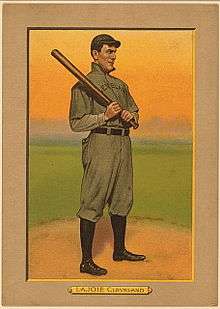
- Greg Abate, musician
- Norm Abram, master carpenter, TV host/personality
- Jonathan Earle Arnold, politician
- Rocco Baldelli, former baseball player and current manager of the Minnesota Twins
- Latimer Whipple Ballou, congressman
- Bryan Berard, hockey player
- Brian Boucher, hockey player
- Percy Daniels, populist politician
- Marcel Desaulniers, chef
- Eddie Dowling, actor, screenwriter and songwriter
- Allen Doyle, golfer
- Draco and the Malfoys, wizard rock band
- Denise Duhamel, poet
- Susan Eisenberg, voice artist
- Eileen Farrell, opera soprano
- Marie Rose Ferron, stigmatist
- Ernest Fortin, theology professor
- Stuart Gitlow, physician
- Edward Harris, manufacturer, philanthropist, and abolitionist
- Gabby Hartnett, baseball player and manager
- Michelle Holzapfel, woodworking artist
- Ambrose Kennedy, congressman
- Clem Labine, baseball player
- Nap Lajoie, baseball player
- Neil Lanctot, historian and author
- Francis Leo Lawrence (1937–2013), college president[22]
- William C. Lovering, congressman
- James McAndrews, congressman
- J. Howard McGrath, politician
- Dave McKenna, jazz pianist
- Isabelle Ahearn O'Neill, Rhode Island's first woman legislator
- Edwin O'Connor, radio personality and novelist
- Aram J. Pothier, governor
- Duke Robillard, blues guitarist
- Christopher Robinson, congressman
- Mathieu Schneider, NHL hockey player
- Bill Summers, umpire
See also
References
- "2019 U.S. Gazetteer Files". United States Census Bureau. Retrieved July 29, 2020.
- "Population and Housing Unit Estimates". United States Census Bureau. May 24, 2020. Retrieved May 27, 2020.
- "U.S. Census website". United States Census Bureau. Retrieved 2008-01-31.
- "US Board on Geographic Names". United States Geological Survey. 2007-10-25. Retrieved 2008-01-31.
- "About Woonsocket". City of Woonsocket. Retrieved January 27, 2009.
- "Woonsocket, Rhode Island - My Home Town - History". www.woonsocket.org.
- Walter Nebiker, The History of North Smithfield (New England History Press: Somersworth, NH: 1976), 12–13.
- "Nipmuc place names of New England". native tach.org. Retrieved April 12, 2008.
- "Historic and Architectural Resources of North Smithfield, Rhode Island: A Preliminary Report," North Smithfield - Rhode Island Historical Preservation & Heritage ..., pg. 63, http://www.preservation.ri.gov/pdfs_zips_downloads/survey_pdfs/north_smithfield.pdf
- Erik Eclison. "Growth of an Industrial City". Woonsocket: My Hometown on the Web. Retrieved January 27, 2009.
- "L'Union St. Jean Baptiste d'Amerique". Worcester Magazine. Vol. XVIII. Worcester Chamber of Commerce; Belisle Printing & Publishing. 1915. pp. 184–185.
- "French Towns in the United States; A Study of the Relative Strength of the French-Speaking Population in Our Large Cities". The American Leader. Vol. IV no. 11. New York: American Association of Foreign Language Newspapers, Inc. December 11, 1913. pp. 672–674.
- Pierre Anctil, "Franco-American in New England" in Dean R. Louder and Eric Waddell, ed., and Franklin Philip, tran. French America: Mobility, Identity and Monority Experience Across the Continent (Baton Rouge: Louisiana State University Press, 1993), p. 40
- Anctil, "Franco-Americans in New England", p. 41
- Philip Marcelo (October 9, 2007). "Woonsocket's Autumnfest draws thousands". Providence Journal. Retrieved January 28, 2009.
- "Intellicast". Weather Underground.
- "Weatherbase: Historical Weather for Woonsocket, Rhode Island". Weatherbase. 2011. Retrieved November 24, 2011.
- "Census of Population and Housing". Census.gov. Retrieved June 4, 2015.
- "Census Quick facts for Woonsocket".
- "Food stamps put Rhode Island town on monthly boom-and-bust cycle". The Washington Post. 2013-03-16. Retrieved 2013-04-14.
- Dani Safford (September 13, 2008). "Woonsocket's Autumnfest draws thousands". The Woonsocket Call. Archived from the original on September 20, 2008. Retrieved January 28, 2009.
- via Associated Press. "Francis Lawrence, Former Rutgers President, Dies at 75", The New York Times, April 17, 2013. Accessed November 30, 2017. "Mount Laurel, N.J. — Francis L. Lawrence, who was president of Rutgers University for 12 years and worked to raise its national profile, died on Tuesday at his home here.... Dr. Lawrence was born on Aug. 25, 1937, and grew up in Woonsocket, R.I. "
External links
| Wikimedia Commons has media related to Woonsocket, Rhode Island. |
| Wikivoyage has a travel guide for Woonsocket. |
| Wikisource has the text of the 1921 Collier's Encyclopedia article Woonsocket. |
